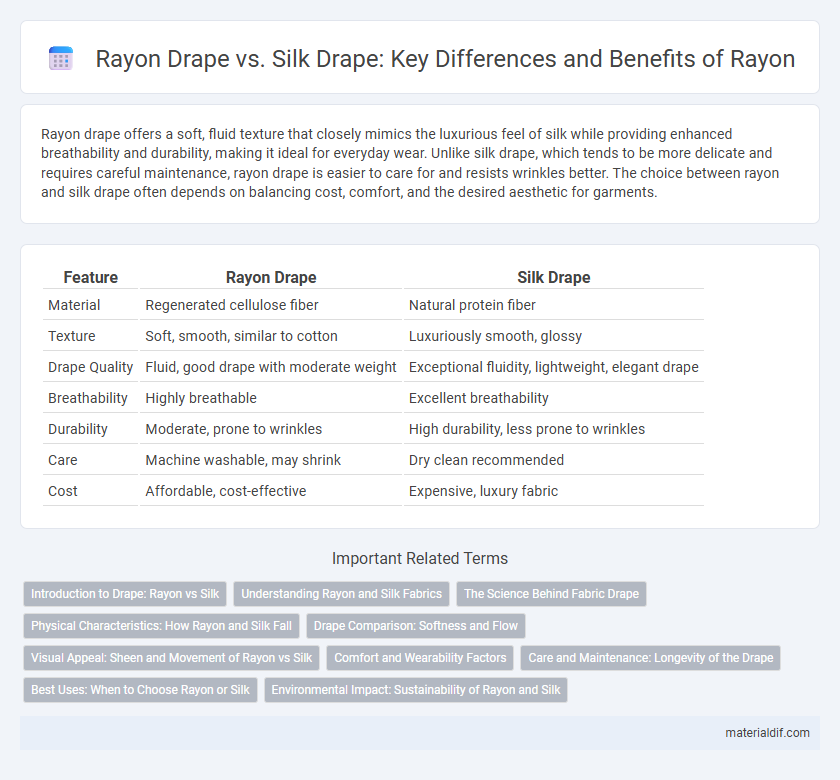Rayon drape offers a soft, fluid texture that closely mimics the luxurious feel of silk while providing enhanced breathability and durability, making it ideal for everyday wear. Unlike silk drape, which tends to be more delicate and requires careful maintenance, rayon drape is easier to care for and resists wrinkles better. The choice between rayon and silk drape often depends on balancing cost, comfort, and the desired aesthetic for garments.
Table of Comparison
| Feature | Rayon Drape | Silk Drape |
|---|---|---|
| Material | Regenerated cellulose fiber | Natural protein fiber |
| Texture | Soft, smooth, similar to cotton | Luxuriously smooth, glossy |
| Drape Quality | Fluid, good drape with moderate weight | Exceptional fluidity, lightweight, elegant drape |
| Breathability | Highly breathable | Excellent breathability |
| Durability | Moderate, prone to wrinkles | High durability, less prone to wrinkles |
| Care | Machine washable, may shrink | Dry clean recommended |
| Cost | Affordable, cost-effective | Expensive, luxury fabric |
Introduction to Drape: Rayon vs Silk
Rayon drape offers a fluid, breathable texture that mimics the natural softness of silk while providing enhanced durability and affordability. Silk drape is renowned for its luxurious sheen and natural elasticity, delivering a smooth, elegant flow that complements formal wear and high-end fashion. Both fibers exhibit excellent draping qualities, but rayon's versatility and cost-effectiveness make it a popular choice for everyday clothing, whereas silk remains the premium option for opulent garments.
Understanding Rayon and Silk Fabrics
Rayon drape offers a fluid and versatile quality due to its semi-synthetic cellulose fibers, which mimic the softness and breathability of natural materials. Silk drape, composed of natural protein fibers from silkworms, provides a luxurious sheen and a smooth texture with exceptional elasticity and strength. Understanding the fiber composition reveals why rayon drapes more heavily and absorbs dyes efficiently, while silk maintains a lighter, more lustrous appearance with temperature-regulating properties.
The Science Behind Fabric Drape
Rayon drape exhibits high fluidity and softness due to its semi-synthetic cellulose fibers, which mimic natural fibers' moisture absorption and flexibility. Silk drape, driven by its protein-based fibroin structure, offers a smoother, more lustrous flow with lightweight elegance and natural elasticity. The science behind fabric drape lies in fiber composition, yarn twist, and fabric construction, directly affecting the way each material conforms, folds, and reacts to movement.
Physical Characteristics: How Rayon and Silk Fall
Rayon drape exhibits a fluid and smooth fall with a moderate sheen, creating a soft, elegant flow that mimics the qualities of natural fibers. Silk drape tends to fall more luxuriously with a glossy finish and a slightly heavier weight, allowing it to cling gently and create rich, sensual folds. The physical characteristics of rayon offer a more matte, breathable feel, whereas silk's natural protein fibers provide a smoother texture and greater luster in garment draping.
Drape Comparison: Softness and Flow
Rayon drape offers a smooth, fluid softness that mimics the luxurious flow of silk but at a more affordable cost and greater breathability. Silk drape provides a natural sheen and exceptional softness with a lightweight flow that gracefully contours the body, enhancing elegance and sophistication. Comparing their drape characteristics, rayon tends to have a slightly heavier weight and more pronounced flow, while silk boasts superior softness and a delicate, airy movement.
Visual Appeal: Sheen and Movement of Rayon vs Silk
Rayon drape exhibits a soft sheen that mimics the natural luster of silk while offering greater fluidity and ease of movement, enhancing garment flow and comfort. Silk drape features a richer, more lustrous glow with a slightly stiffer hand, creating elegant, structured folds that catch light distinctively. The visual appeal of rayon lies in its versatile sheen and supple drape, whereas silk captivates with its luxurious shine and graceful movement.
Comfort and Wearability Factors
Rayon drape offers exceptional breathability and moisture absorption, making it highly comfortable and suitable for warm climates compared to silk drape, which tends to retain heat. The soft and lightweight texture of rayon enhances wearability by providing a smooth feel against the skin without causing irritation. Silk drape, while luxurious and lustrous, requires delicate care and may feel less comfortable during prolonged wear due to its lower moisture-wicking properties.
Care and Maintenance: Longevity of the Drape
Rayon drapes require gentle hand washing or dry cleaning to maintain their softness and prevent shrinking, offering good durability with proper care. Silk drapes demand more delicate handling, such as professional dry cleaning, to preserve their natural sheen and prevent fabric weakening, which can affect longevity. While silk drapes offer a luxurious appearance, rayon drapes generally provide easier maintenance and longer-lasting wear under regular use.
Best Uses: When to Choose Rayon or Silk
Rayon drape offers a soft, fluid texture ideal for casual wear, summer dresses, and lightweight blouses due to its breathability and affordability, making it perfect for daily and versatile apparel. Silk drape provides a luxurious sheen and elegant flow suited for formal occasions, evening gowns, and high-end fashion where a rich appearance and smooth feel are desired. Choosing rayon is best for budget-friendly, comfortable clothing, while silk excels in sophisticated designs requiring durability and a premium look.
Environmental Impact: Sustainability of Rayon and Silk
Rayon, a semi-synthetic fiber derived from cellulose, generally has a lower environmental impact compared to silk, which is produced from silkworms and involves intensive resource use. The sustainability of rayon improves with eco-friendly practices like using closed-loop manufacturing processes that recycle chemicals and water, reducing pollution. Conversely, conventional silk production requires significant water, mulberry cultivation, and involves ethical concerns regarding silkworms, making its environmental footprint higher than responsibly produced rayon.
Rayon Drape vs Silk Drape Infographic

 materialdif.com
materialdif.com